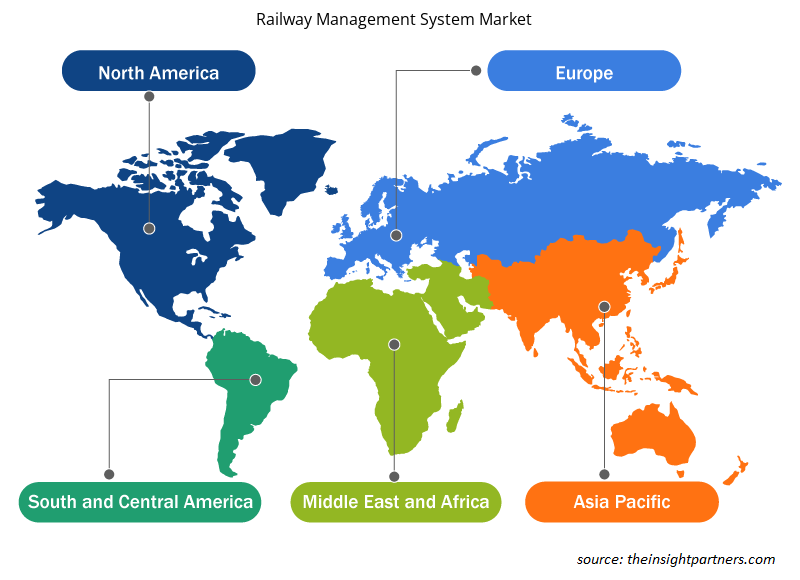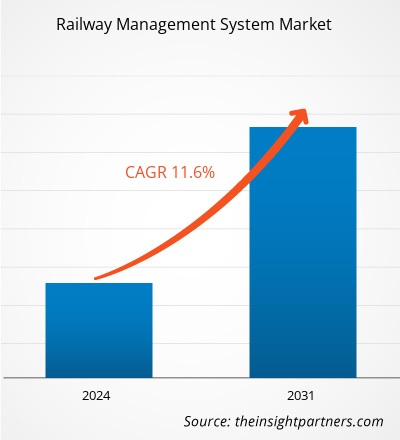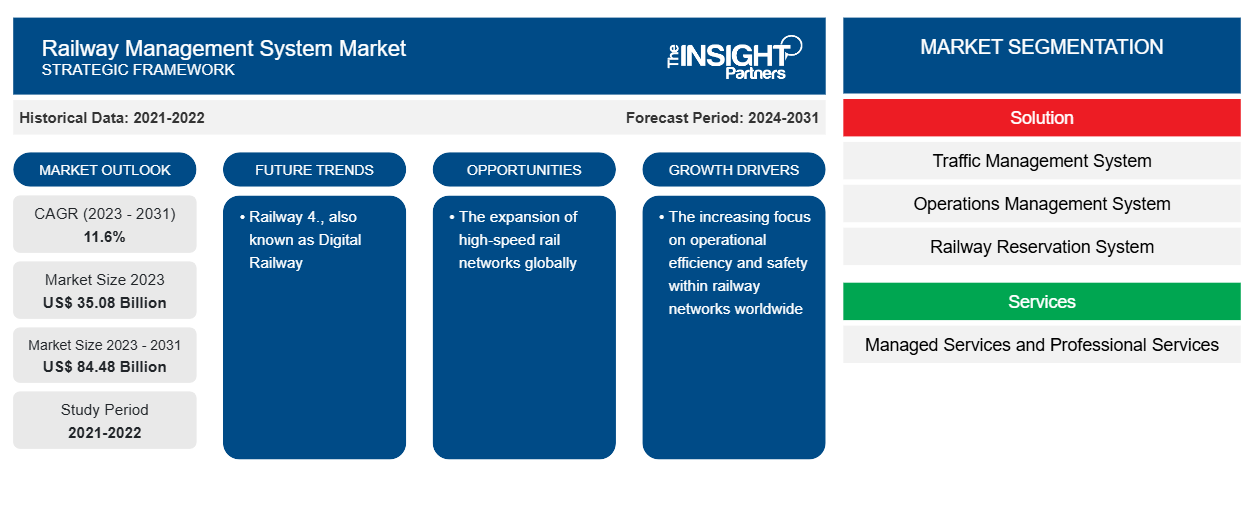철도 관리 시스템 시장 규모는 2023년 350억 8천만 달러에서 2031년까지 844억 8천만 달러에 도달할 것으로 예상됩니다. 이 시장은 2023~2031년에 11.6%의 CAGR을 기록할 것으로 예상됩니다. 디지털 철도라고도 알려진 Railway 4.0은 주요 철도 관리 시스템 시장 트렌드로 남을 가능성이 높습니다.
철도 관리 시스템 시장 분석
철도 관리 시스템 시장은 인프라 개발 및 운송 기술의 다양한 추세에 따라 성장하고 있습니다. 이러한 시스템은 실시간 모니터링 및 예측 유지 관리와 같은 기능보다 운영 효율성, 안전성 및 승객 경험 향상에 중점을 둡니다. 시장을 주도하는 여러 기술에는 AI(인공지능), IoT(사물 인터넷), 클라우드 컴퓨팅이 있으며, 이를 통해 철도 운영의 원격 최적화 및 관리가 가능합니다. 전반적으로 철도 관리 시스템 시장은 철도 효율성, 안전성 및 지속 가능성을 개선해야 한다는 필수성에 따라 전 세계적으로 성장하고 확장되고 있습니다.
철도 관리 시스템 시장 개요
철도 관리 시스템은 철도 네트워크를 효율적으로 관리하고 운영하기 위한 여러 프로세스와 기술을 포함합니다. 여기에는 화물 관리, 티켓 시스템, 승객 정보, 열차 일정, 유지 관리 일정 및 안전 모니터링과 같은 구성 요소가 포함됩니다. 이 시스템은 GPS, 통신 네트워크 및 IoT 센서와 같은 첨단 기술을 활용하여 경로 계획을 최적화하고 안전을 보장하며 열차를 실시간으로 추적할 수 있습니다. 좌석 예약, 온라인 티켓 예약 및 열차 일정에 대한 실시간 업데이트를 통해 승객 서비스가 향상됩니다. 또한 유지 관리 활동이 합리화되고 가동 중지 시간이 줄어들고 예측 유지 관리 기술을 사용하여 전반적인 운영 효율성이 향상됩니다.
귀하의 요구 사항에 맞게 이 보고서를 사용자 정의하세요
이 보고서의 일부 또는 국가 수준 분석, Excel 데이터 팩을 포함하여 모든 보고서에 대한 사용자 정의를 무료로 받을 수 있으며 신생 기업 및 대학을 위한 훌륭한 혜택과 할인 혜택을 이용할 수 있습니다.
-
이 보고서의 주요 시장 동향을 알아보세요.이 무료 샘플에는 시장 동향부터 추정 및 예측까지 다양한 데이터 분석이 포함됩니다.
철도 관리 시스템 시장 동인 및 기회
전 세계 철도 네트워크 내에서 운영 효율성과 안전성에 대한 관심이 높아지고 있습니다.
승객과 화물량이 증가함에 따라 철도 운영자는 열차 일정, 선로 유지 관리 및 전반적인 네트워크 성능을 최적화하기 위해 고급 관리 시스템을 도입하고 있습니다. 이러한 시스템은 IoT 센서, 예측 분석 및 실시간 모니터링과 같은 기술을 활용하여 안전을 강화하고 지연을 최소화하며 운영 비용을 절감합니다. 철도 관리 시스템은 효율성과 안정성을 개선하여 증가하는 고객 기대치와 규제 표준을 충족하는 데 도움이 됩니다.
전 세계 고속철도망 확대
많은 국가가 고속열차를 지원하기 위해 철도 인프라를 현대화하는 데 투자하고 있으며, 더 빠르고 지속 가능한 운송 옵션을 제공합니다. 이러한 추세는 더 높은 속도에서 복잡한 작업을 관리하고 다양한 철도 네트워크에서 원활한 연결을 보장할 수 있는 고급 철도 관리 솔루션에 대한 상당한 수요를 창출합니다. 고속철도 프로젝트가 계속 확장됨에 따라 혁신적인 철도 관리 시스템 시장은 상당한 성장을 앞두고 있습니다. 따라서 전 세계적으로 고속철도 네트워크가 확장됨에 따라 예측 기간 동안 철도 관리 시스템 시장 참여자에게 새로운 기회가 제공될 것으로 예상됩니다.
철도 관리 시스템 시장 보고서 세분화 분석
철도 관리 시스템 시장 분석에 기여한 주요 세그먼트는 솔루션과 배포 유형입니다.
- 해당 솔루션을 기준으로 철도 관리 시스템 시장은 교통 관리 시스템, 운영 관리 시스템, 철도 예약 시스템, 승객 정보 시스템, 유지 관리 시스템 및 기타로 구분됩니다.
- 철도 관리 시스템 시장은 서비스 기준으로 관리 서비스와 전문 서비스로 구분됩니다.
- 배포 유형별로 시장은 온프레미스와 클라우드로 세분화됩니다. 클라우드 세그먼트는 2023년에 더 큰 시장 점유율을 차지했습니다.
지역별 철도 관리 시스템 시장 점유율 분석
철도 관리 시스템 시장 보고서의 지리적 범위는 주로 북미, 아시아 태평양, 유럽, 중동 및 아프리카, 남미/남중부 아메리카의 5개 지역으로 나뉩니다. 수익 측면에서 유럽은 가장 큰 철도 관리 시스템 시장 점유율을 차지했습니다. 유럽에서는 확립된 철도 네트워크 와 효율성에 대한 집중으로 인해 안전, 정시성 및 승객 경험을 향상시키는 고급 관리 시스템에 대한 수요가 증가하고 있습니다. 독일과 프랑스와 같은 국가는 열차 제어, 신호 및 유지 관리를 위한 최첨단 기술 도입을 선도하고 있습니다.
철도 관리 시스템 시장 지역 통찰력
Insight Partners의 분석가들은 예측 기간 동안 철도 관리 시스템 시장에 영향을 미치는 지역적 추세와 요인을 철저히 설명했습니다. 이 섹션에서는 북미, 유럽, 아시아 태평양, 중동 및 아프리카, 남미 및 중미의 철도 관리 시스템 시장 세그먼트와 지리에 대해서도 설명합니다.

- 철도 관리 시스템 시장에 대한 지역별 특정 데이터를 얻으세요
철도 관리 시스템 시장 보고서 범위
| 보고서 속성 | 세부 |
|---|---|
| 2023년 시장 규모 | 350억 8천만 달러 |
| 2031년까지 시장 규모 | 844억 8천만 달러 |
| 글로벌 CAGR (2023-2031) | 11.6% |
| 역사적 데이터 | 2021-2022 |
| 예측 기간 | 2024-2031 |
| 다루는 세그먼트 |
솔루션별로
|
| 포함된 지역 및 국가 |
북아메리카
|
| 시장 선도 기업 및 주요 회사 프로필 |
|
철도 관리 시스템 시장 참여자 밀도: 비즈니스 역학에 미치는 영향 이해
철도 관리 시스템 시장은 소비자 선호도의 변화, 기술 발전, 제품의 이점에 대한 인식 증가와 같은 요인으로 인해 최종 사용자 수요가 증가함에 따라 빠르게 성장하고 있습니다. 수요가 증가함에 따라 기업은 제품을 확장하고, 소비자의 요구를 충족하기 위해 혁신하고, 새로운 트렌드를 활용하여 시장 성장을 더욱 촉진하고 있습니다.
시장 참여자 밀도는 특정 시장이나 산업 내에서 운영되는 회사나 기업의 분포를 말합니다. 주어진 시장 공간에 얼마나 많은 경쟁자(시장 참여자)가 존재하는지 그 규모나 총 시장 가치에 비해 나타냅니다.
철도 관리 시스템 시장에서 운영되는 주요 회사는 다음과 같습니다.
- 봄바디어 주식회사
- DXC 기술 회사
- EKE-일렉트로닉스 유한회사
- 제너럴 일렉트릭 회사
- 히타치 주식회사
- 화웨이 테크놀로지 주식회사
면책 조항 : 위에 나열된 회사는 어떤 특별한 순서에 따라 순위가 매겨지지 않았습니다.

- 철도 관리 시스템 시장 주요 주요 업체 개요를 알아보세요
철도 관리 시스템 시장 뉴스 및 최근 개발
철도 관리 시스템 시장은 1차 및 2차 연구 이후의 질적, 양적 데이터를 수집하여 평가합니다. 여기에는 중요한 기업 간행물, 협회 데이터 및 데이터베이스가 포함됩니다. 다음은 언어 장애 및 전략 시장에서의 개발 목록입니다.
- 2023년 8월, 레스토랑을 위해 구축된 올인원 기술 플랫폼인 Toast는 Toast Catering & Events를 출시한다고 발표했습니다. 이는 Toast POS(Point-of-Sale)와 완벽하게 통합되어 레스토랑이 대량 케이터링 주문과 이벤트 계획을 원활하게 관리할 수 있도록 돕는 새로운 제품입니다. Toast Catering & Events는 사용자 정의 가능한 연회 이벤트 주문(BEO), 이행 도구 및 리드 관리 기능을 지원합니다. (출처: Toast, 보도자료)
- 2021년 6월, 세계 최고의 케이터링 소프트웨어 공급업체인 FoodStorm은 매장 내 고객이 하나의 관리형 백엔드로 케이터링, 조리식품, 델리, 베이커리 품목을 주문할 수 있는 물리적 셀프 서비스 키오스크인 FoodStorm Kiosk를 출시한다고 발표했습니다. (출처: FoodStorm, 보도자료)
철도 관리 시스템 시장 보고서 범위 및 제공물
"철도 관리 시스템 시장 규모 및 예측(2023-2031)" 보고서는 아래 영역을 포괄하는 시장에 대한 자세한 분석을 제공합니다.
- 범위에 포함된 모든 주요 시장 세그먼트에 대한 글로벌, 지역 및 국가 수준의 시장 규모 및 예측
- 동인, 제약 및 주요 기회와 같은 시장 역학
- 주요 미래 트렌드
- 자세한 PEST/포터의 5가지 힘과 SWOT 분석
- 주요 시장 동향, 주요 업체, 규정 및 최근 시장 동향을 포괄하는 글로벌 및 지역 시장 분석
- 시장 집중도, 히트맵 분석, 유명 기업 및 최근 개발 사항을 포함하는 산업 환경 및 경쟁 분석
- 자세한 회사 프로필
- 과거 분석(2년), 기준 연도, CAGR을 포함한 예측(7년)
- PEST 및 SWOT 분석
- 시장 규모 가치/거래량 - 글로벌, 지역, 국가
- 산업 및 경쟁 환경
- Excel 데이터세트
최근 보고서
관련 보고서
사용 후기
구매 이유
- 정보에 기반한 의사 결정
- 시장 역학 이해
- 경쟁 분석
- 고객 인사이트
- 시장 예측
- 위험 완화
- 전략 기획
- 투자 타당성 분석
- 신흥 시장 파악
- 마케팅 전략 강화
- 운영 효율성 향상
- 규제 동향에 발맞춰 대응























 무료 샘플 받기 - 철도 관리 시스템 시장
무료 샘플 받기 - 철도 관리 시스템 시장